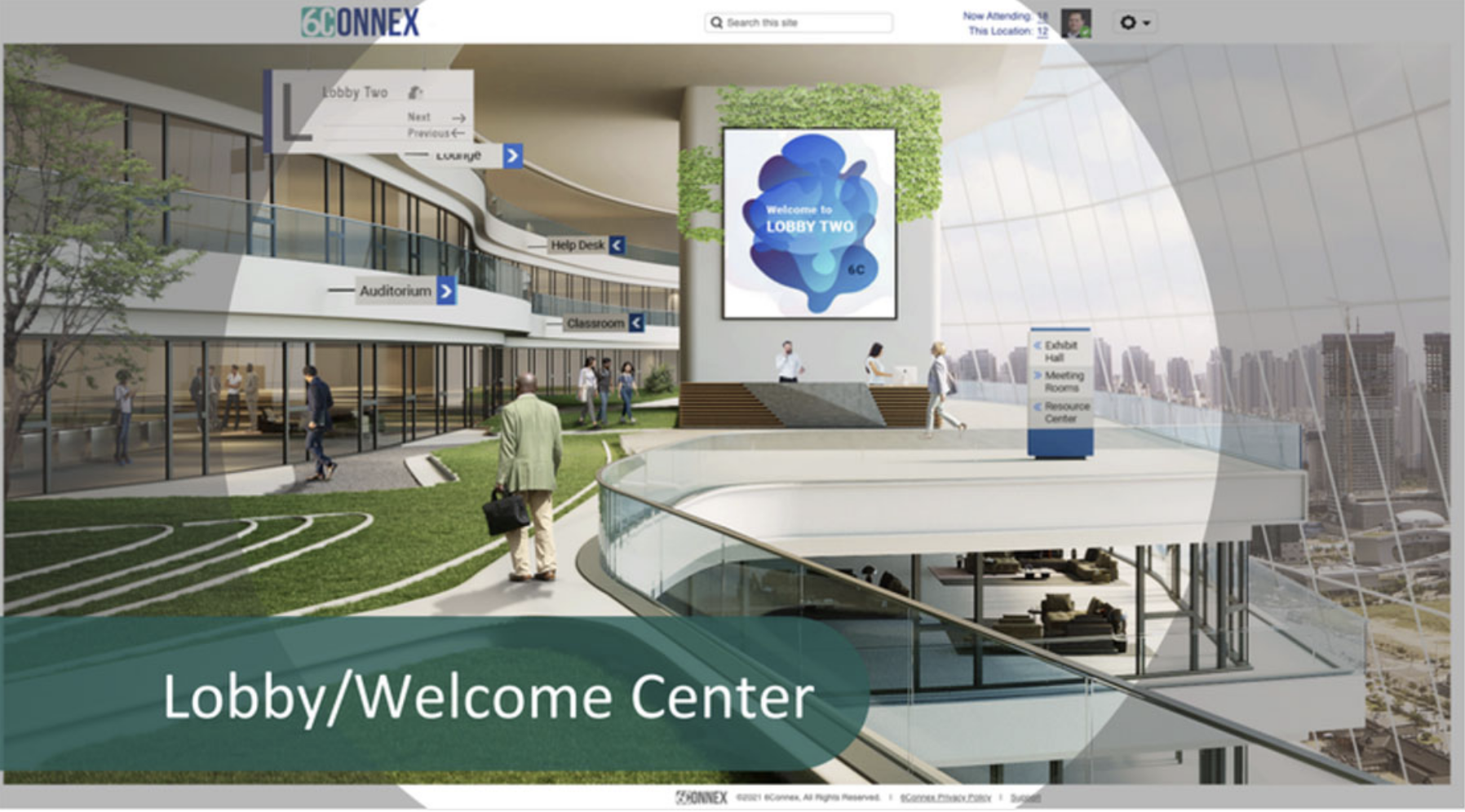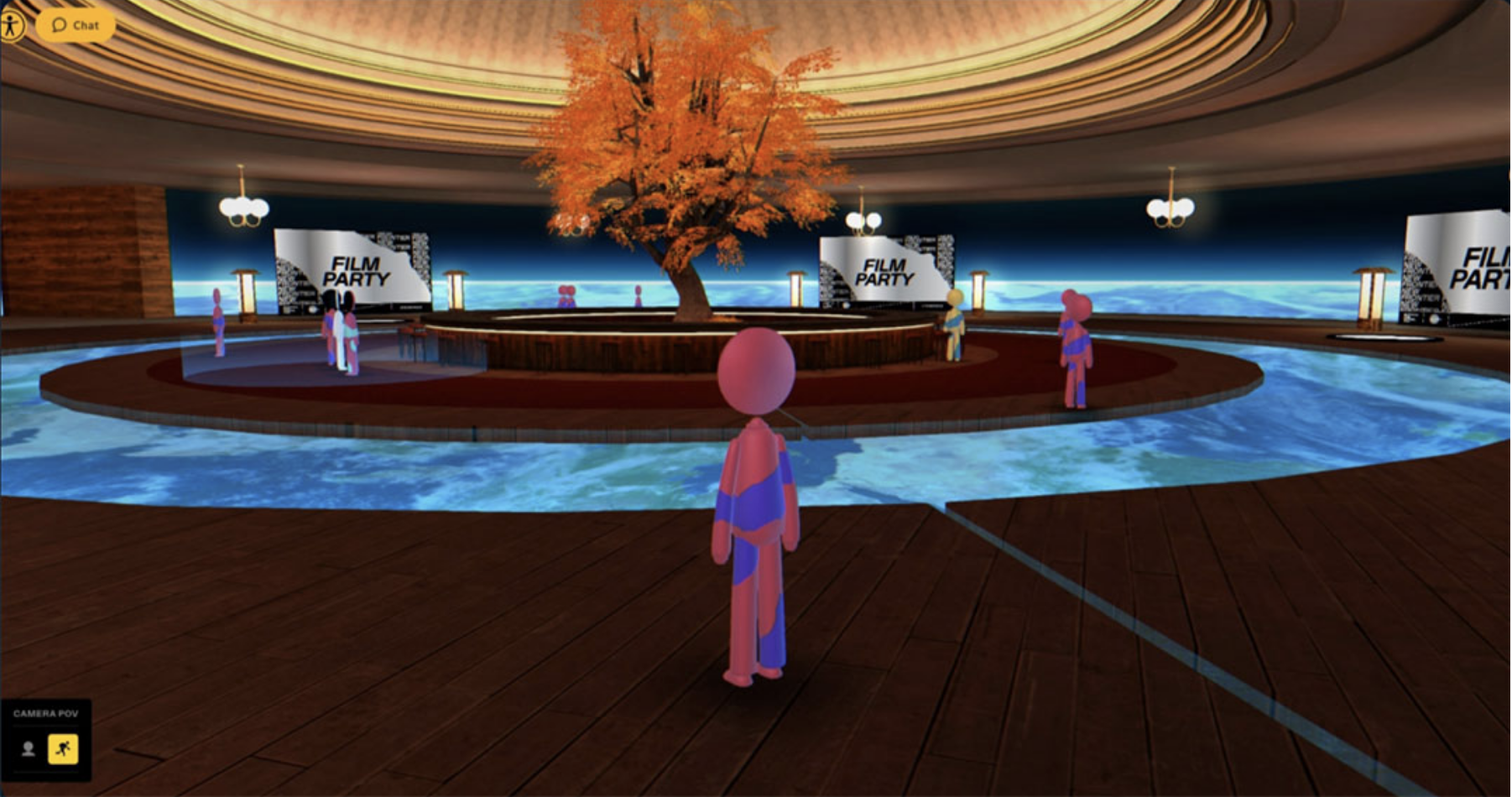A FIELD GUIDE TO VIRTUAL EVENT PLATFORMS: CHAPTER 3 – VIRTUAL IMMERSION PLATFORMS
This post was part of a content series I wrote in 2020 & 2021 at August Jackson looking at the virtual event platform space. Chapter 3 covers virtual immersion platforms and a look ahead at what Hybrid Events might become, circa April 2021.
In Chapter Three of the Field Guide to Virtual Event Platforms, we start with a quote from Benedict Evans, noted independent analyst and former partner at Andreesen Horowitz, who wrote “…Every time we get a new tool, we start by forcing it to fit the old way of working, and then one day we realize that it lets us do the work differently, and indeed change what the work is.” It’s a prescient quote that sets the stage for this article on Virtual Immersion Platforms.
At AJ, we define Virtual Immersion Platforms as cloud-based event software that attempts to recreate the live event/conference setting with a simulated lobby, keynote theater (for live, simulive, and pre-recorded content), virtual tradeshow booths and networking centers.
As we noted in Chapter One, the Virtual Event space is undergoing fundamental changes that will last for next few years due to the pandemic. In March 2020, Virtual Immersion platforms gained in popularity due to the fact that they recreated places that we couldn’t gather in and made 100% sense as a way to ground attendees in the event dynamic. In Chapter Two, we looked at Virtual Experience platforms across the three stages of an event, pre, during and post. For Virtual Immersion platforms, we will think about the experiences in layers, not stages. This layered approach was inspired by the November 2020 6Connex Webinar, “Plotting your Virtual Event Strategy for 2021-and Beyond” with 6Connex CEO Ruben Castano, Wainhouse Research Senior Analyst Steve Vonder Haar, and Joakim Jonsson, GM 6Connex EMEA. In the webinar, they talk about the three layers of virtual events: Visual, Interactive and Data.
THE VISUAL LAYER OF VIRTUAL IMMERSION PLATFORMS
6Connex Lobby via The Blueprint
To begin, the visual layer of Virtual Immersion Platforms contains two elements, the presentation of the space and then the video stream where the content lives. The presentation of the space is where there are significant differences. On one side, there are the platforms that create virtual lobbies that are approximations of conference lobbies complete with elevators, banners hanging from the ceiling and representations of people milling around. Platforms like 6Connex offer these along with vFairs and Inxpo (Intrado). This recreation of a conference space to establish the event mechanic makes sense, that said, they can feel like a low-fidelity experience. On the other side, there are more abstract experiences like what was designed for the Sundance Film Festival that are entirely new spaces with no common reference to a physical space. In a sense, both types of virtual lobbies encourage exploration and set the tone for what the experience will be.
Sundance New Frontier via Dreamwave
A middle is emerging with companies like Spatial who are creating spaces beyond a conference setting for commerce and gathering, like an art gallery setting where you and your avatar can take in the scene. It should also be noted that in some cases, these experiences can be taken in via a VR headset so that you are beamed into these settings for a more immersive view.
From the video perspective, all provide video portals for the broadcast and content can be presented one to many, one to one and small group meetings. In some cases, videos are presented in faux movie theater settings, another attempt at providing context to the experience. This visual layer of Virtual Immersion platforms will likely evolve significantly as we move to hybrid events, with more detail added to truly establish a sense of place (Javits Center vs. Las Vegas Convention Center, etc.) so that virtual attendees don’t experience too much visual dissonance when they arrive at a place.
THE INTERACTIVE LAYER OF VIRTUAL IMMERSION PLATFORMS
Next up for Virtual Immersion Platforms is the interactive layer, arguably the most challenging area for any event platform to provide organic engagement. Nearly every platform offers the basics of networking, break out rooms, live chat, video on demand, etc. Some, like Brella, are upping the engagement game by providing algorithms for matchmaking which provide relevant connections that deepen interactions.
Virbela, a company founded by organization psychologists, has arguably one of the most unique approaches to solving interactivity by creating virtual worlds that include offices, conferences, town hall squares and expo halls. The platform gives users agency by having them create an avatar who then travels through the virtual world and interacts with others who are there. These interactions include the ability to talk 1:1 via spatial audio in either public or private spaces, play games from scavenger hunts to soccer, and participate in meetings or round tables all with the ability to share video content via portals in the virtual world. The real key to interactivity here is that the user has agency and is forced to direct where their avatar goes, rather than focusing on watching others in a Zoom frame. The other interesting piece to this approach is that everyone else who is in this world is a person, not a bot. This provides for an approximation of serendipity and organic-ness that just isn’t possible on video-based platforms.
VirBELA via Ryan Schultz
THE DATA LAYER OF VIRTUAL IMMERSION PLATFORMS
All of this activity, visual and interactive, rolls up to the data layer. Arguably the biggest benefit to virtual events is the ability to understand every aspect of the experience and be able to act on that information either to follow up with an attendee or to make the next event more engaging. This is the space that pre-pandemic was largely in the back seat, and now will likely be the one reasons, beyond scale, that virtual events remain long after the pandemic ends. Afterall, what marketer will not want to maximize their reach and understand what the engagement rate was for their event post-pandemic? A platform that has an advanced data layer is Meeting Play, as evidenced by their ability to, in addition all of the visual and interactive functionalities mentioned above, provide mature personalization tools to help attendees network while filtering session and agenda content. It is this ability to deploy algorithms across a Virtual Immersion Platform that really offers a glimpse of what’s to come. As we think about virtual events being used as a media channel, the data layer will be the key area where marketers will look to understand ROI as compared to the other media channels they are using to reach audiences.
THE ROAD TO HYBRID
Getting back to the Evans quote, it is clear that Virtual Immersion Platforms are expanding what it means to gather both in form and in function. When we think about having had the ability to ‘do the work differently’ now for the past 15 months, it shouldn’t be a surprise that we are at the stage of re-imagining and moving to the ‘change what the work is’ phase. This is particularly evident in the conversations currently being had about hybrid events. This is the space where there will be an intense period of innovation as we start to see multiple audiences gathering across physical and virtual spaces. The ability to bring these audiences together equally will be the key to the evolution of hybrid events. We believe mobile will be an important tool to enable the connection, particularly when, according to Markletic’s February 2021 survey of 3,000 event organizers, “71.1% of event organizers say that connecting the in-person and virtual audience is their biggest challenge.” Mobile will become the key tool to ‘change what the work is’ in the evolution of hybrid events.
Here are thoughts on how hybrid evolves that emerged from conversations I had with Jeremy Patuto CEO of Eventfinity and Brandon Wernli, President of BW Events:
In-person audiences will have an augmented experience and will be able to rely on the crowd in the cloud to fill out their experience via mobile.
Keynotes and sessions may get shorter to allow time for people to interact face to face.
The in-person cohort can act as a tele-present guide through their mobile device to the online cohort either livestreaming what is happening off-camera or isn’t being covered.
To build on the recommendation engines mentioned above, it will make sense to also have the ability to combine online recommendations with physical recommendations for either booths to visit or sessions to attend. Again, when we think about what tool can enable this, it is clear that mobile will be the primary device that can aid in recommendations using location tracking and other technologies to make the in-person experience smart and anticipatory.
Gamification of the entire booth experience will explode and we will start see functionality where a rep can broadcast on the spot from their mobile device to an audience of 1 in person at the booth and to 30 virtually.
Finally, a suggestion on where to look for a view into the future of hybrid events: The CBS TV show Let’s Make a Deal. Seriously, take a few minutes and watch how both the in-person and remote audiences are treated equally and get to participate together. I was initially skeptical when Patuto made this recommendation, but I immediately saw the analogue. Both audiences are extremely passionate about participating and engaging around the shared experience, and that should be the beginning of how to think about designing hybrid experiences.
Let’s Make a Deal via CBS





